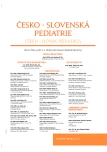Early and late morbidity and mortality in twins born between 24th and 36th gestational week in and outside perinatology center
Authors:
D. Bařinová 1; J. Pavlíček 2,3; I. Matyáštíková 1; V. Sobolová 1; A. Střídová 1; K. Sitárová 1; P. Zárubová 1; H. Wiedermannová 1,3; H. Burčková 1; A. Piegzová 4
Authors‘ workplace:
Oddělení neonatologie, FN Ostrava
1; Klinika dětského lékařství, FN Ostrava
2; Lékařská fakulta, Ostravská univerzita
3; Gynekologicko-porodnická klinika, FN Ostrava
4
Published in:
Čes-slov Pediat 2020; 75 (3): 146-153.
Category:
Original Papers
Overview
Aim: Study of early and late morbidity and mortality in neonates from twin pregnancy. Analysis of these factors in relation to gestational week and birth in a perinatal care center or outside it.
Methods: The retrospective analysis was conducted between 2008 and 2017 in the Moravian-Silesian Region. Data was acquired from medical records of the University Hospital Ostrava and from the records of general practitioners for children. The early and late morbidity and mortality were monitored in groups according to gestational weeks. The patients were divided into those born in a perinatal care center and outside it, followed by transport into the University Hospital Ostrava.
Results: During the study years, a total of 1,464 children from twin pregnancies born between the 24th and 36th gestational week were hospitalized in the University Hospital Ostrava. In the perinatal care center, 93% (1,364/1,464) of newborns were born and 7% (100/1,464) were transported to the University Hospital Ostrava from other hospitals. The most common diseases observed in the early period were respiratory distress syndrome in 25% (365/1,464) and bronchopulmonary dysplasia in 7% (99/1,464) of cases. Concerning late morbidity, the most commonly observed condition was growth retardation, found in 3% (32/1,209) of children. The early neonatal mortality rate was 0.4% (6/1,464). In the group of children born outside the perinatology center, there was a significantly higher incidence of intraventricular hemorrhage Grade III and IV (p=0.004) and cerebral palsy (p=0.005) in very preterm neonates.
Conclusion: Centralization of perinatal care is essential in providing care for preterm newborns. This is emphasized in multiple pregnancies, which tend to be more premature, and the children are at greater risk of morbidity and mortality.
Keywords:
morbidity – newborn – Twins – prematurity – neonatal mortality
Sources
1. Porodnost a plodnost 2006 až 2010. Praha: Český statistický úřad, 2011: 25–26. https://www.czso.cz/csu/czso/cri/porodnost-a-plodnost-2006-az-2010-bei2lxvhdf
2. Kulkarni AD, Jamieson DJ, Jones HW Jr, et al. Fertility treatments and multiple births in the United States. N Engl J Med 2013; 369 (23): 2218–2225.
3. Velebil P. Výsledky perinatální péče v České republice za rok 2018. Praha: 2019. https://www.mzcr.cz
4. Porodnost a plodnost 2011 až 2015. Praha: Český statistický úřad, 2016: 6–7. https://www.czso.cz/csu/czso/porodnost-a-plodnost-2011–2015
5. Jírová J. Zpráva o novorozenci 2012. Praha: ÚZIS ČR, 2013: 1–2. https://www.uzis.cz/rychle-informace/zprava-novorozenci-2012
6. Blondel B, Kogan MD, Alexander GR, et al. The impact of the increasing number of multiple births on the rates of preterm birth and low birthweight: an international study. Am J Public Health 2002; 92 (8): 1323–1330.
7. Martin JA, Hamilton BE, Osterman MJK, et al. Births: final data for 2013. Nati Vital Stat Rep 2015; 64 (1): 1–65.
8. Papiernik E, Zeitlin J, Delmas D, et al. Differences in outcome between twins and singletons born very preterm: results from a population-based European cohort. Hum Reprod 2010; 25 (4): 1035–1043.
9. Porta R, Capdevila E, Botet F, et al. Morbidity and mortality of very low birth weight multiples compared with singletons. J Matern Fetal Neonatal Med 2019; 32 (3): 389–397.
10. Štembera Z, Langhammer P. Vývoj vrozených vývojových vad u dvojčat v ČR v mezinárodním srovnání. Čes Gynek 2009; 2: 97–101.
11. Phibbs C, Baker L, Caughey A, et al. Level and volume of neonatal intensive care and mortality in very-low-birth-weight infants. N Engl J Med 2007; 356: 2165–2175.
12. Lasswell S, Barfield W, Rochat R, Blackmon L. Perinatal regionalization for very low-birth-weight and very preterm infants: a meta-analysis. J Am Med Assoc 2010; 304: 992–1000.
13. Lorch S, Baiocchi M, Ahlberg C, Small D. The differential impact of delivery hospital on the outcomes of premature infants. Pediatrics 2012; 130: 270–278.
14. Synnes A, MacNab Y, Qiu Z, et al. Neonatal intensive care unit characteristics affect the incidence of severe intraventricular hemorrhage. Med Care 2006; 44: 754–759.
15. Gomella TL, Cunningham MD, Eyal FG. Neonatology: Management, Procedures, On-call Problems, Diseases, and Drugs. New York: Lange Medical Books, 2004: 570.
16. Steer P. The epidemiology of preterm labour. BJOG Br J Obtstet Gynaecol 2005; 112: 1–3.
17. Stoll BJ, Hansen NI, Bell EF, et al. Neonatal outcomes of extremely preterm infants from the NICHD Neonatal Research Network. Pediatrics 2010; 126 (3): 443–456.
18. Smíšek J, Plavka R. Výsledky péče o extrémně nezralé novorozence v České neonatologické síti. Čes-slov Pediat 2018; 73 (1): 5–9.
19. Ancel PY, Goffinet F. Survival and morbidity of preterm children born at 22 through 34 weeks‘ gestation in France in 2011: results of the EPIPAGE-2 cohort study. JAMA Pediatr 2015; 169 (3): 230–238.
20. Zoban P. Hlavní faktory ovlivňující kvalitu života perinatálně ohrožených novorozenců. Špindlerův Mlýn: 2014. http://www.neonatology.cz/upload/www.neonatology.cz/morbidita/pm-2011.pdf.
21. Zoban P. Nedonošený novorozenec. Čes-slov Pediat 2012; 67 (3): 203–212.
22. Plavka R, Smíšek J. Neonatální mortalita a morbidita Česká republika 2017. Mikulov: 2018. http://www.neonatology.cz/upload/www.neonatology.cz/morbidita/nu-2017-pro-www.pdf.
23. McIntire DD, Leveno KJ. Neonatal mortality and morbidity rates in late preterm births compared with births at term. Obstet Gynecol 2008; 111: 35–41.
24. Suhag A, Berghella V. Intrauterine Growth Restriction (IUGR): Etiology and diagnosis. Curr Obstet Gynecol Rep 2013; 2: 102–111.
Labels
Neonatology Paediatrics General practitioner for children and adolescentsArticle was published in
Czech-Slovak Pediatrics

2020 Issue 3
Most read in this issue
- Abdominal pain at girls in childhood and adolescent age
- Genital bleeding in childhood view by pediatric gynecologist
- Female genital tract congenital anomalies – development defects of Müllerian ducts and their derivatives – ultrasound diagnosis in pediatric and adolescent gynecology
- Eisenmenger syndrome and complications in children – case report
